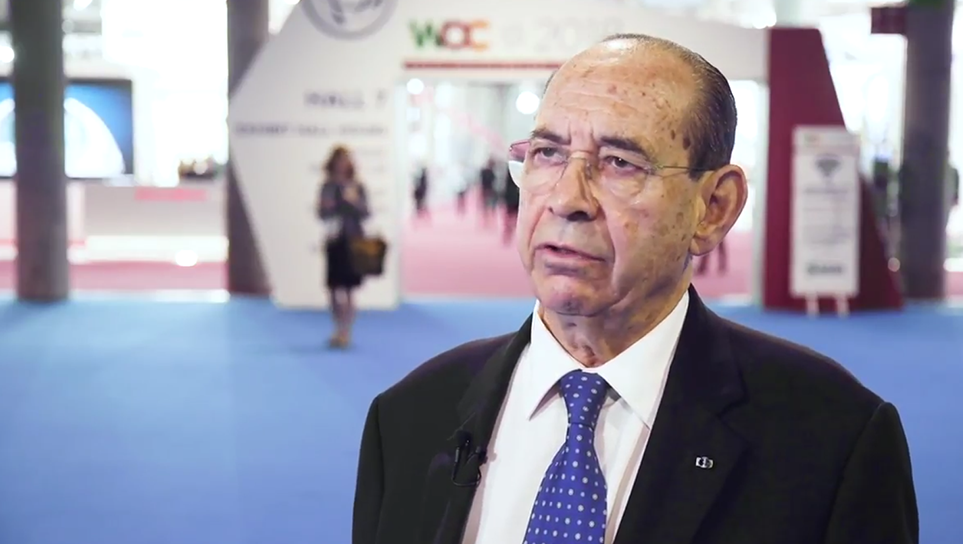The EURETINA 2024 Congress, held in Barcelona from September 19-22, brought together leading experts in ophthalmology to share the latest research and innovative treatments for retinal diseases. Among the highlights were several late-breaking abstracts that showcased promising advances in therapeutics for conditions such as retinopathy of prematurity (ROP), diabetic retinopathy (DR) and age-related macular degeneration (AMD). These studies not only demonstrated the efficacy and safety of novel treatment options but also addressed critical unmet needs in reducing patient burden and improving long-term outcomes.
From the FIREFLEYE next study, which explored the benefits of intravitreal aflibercept in children with ROP, to the HELIOS trial’s results on a sustained-release axitinib implant for DR, these presentations offered valuable insights into the future of retinal care. Below, we provide an overview of these key findings and their potential impact on clinical practice.
 AVD-104 demonstrates safety and visual acuity improvements in geographic atrophy
AVD-104 demonstrates safety and visual acuity improvements in geographic atrophy
A single injection of AVD-104 showed promising safety and efficacy, improving visual acuity and reducing geographic atrophy (GA) lesion growth in patients with GA secondary to AMD over 3 months, according to interim results from the phase IIa SIGLEC trial.
The phase IIa SIGLEC trial is a multicentre, prospective, dose-escalation study assessing the safety and efficacy of AVD-104, a sialic acid-coated nanoparticle designed to modulate retinal inflammation. A total of 30 patients with bilateral GA due to AMD were enrolled and received a single intravitreal injection of AVD-104 at doses ranging from 0.1 mg to 3.0 mg.
At 3 months, AVD-104 demonstrated an excellent safety profile, with no dose-limiting toxicities or serious ocular adverse events observed. In terms of efficacy, patients across all dose cohorts showed improvements in best corrected visual acuity (BCVA), with the highest-dose groups (1.0 mg and 3.0 mg) showing mean gains of +4.8 and +6.5 ETDRS letters, respectively. Additionally, the GA lesion growth rate, as measured by definitely decreased autofluorescence (DDAF), was reduced by 19% across all patients, with the high-dose groups showing a 48% reduction compared to fellow eyes.
These early results suggest AVD-104 is a safe and potentially effective therapy for GA, with ongoing phase IIb trials aiming to further evaluate its efficacy against an active comparator.
View the full abstract: Visual Outcomes and Safety Data After a Single Injection of AVD-104 in Patients with Geographic Atrophy Secondary to AMD in the Phase 2a SIGLEC Trial. Presenter: Anat Loewenstein (Israel)
PRIMA retinal implant shows promising safety and significant visual acuity improvement in geographic atrophy in the PRIMAvera trial
The PRIMA retinal implant system demonstrated promising safety and clinically meaningful improvement in visual acuity for patients with geographic atrophy due to AMD after 12 months of follow-up, according to interim results from the PRIMAvera clinical trial.
In this pivotal, open-label, non-randomized study conducted across 17 clinical sites in Europe and the UK, 38 patients aged 60 or older with advanced geographic atrophy and severe visual impairment (logMAR 1.2 or worse) received the PRIMA implant. The PRIMA system consists of an implantable photovoltaic microchip and augmented reality glasses that capture and process visual information, projecting it onto the macula via near-infrared light.
Results showed that, at 12 months post-implantation, at least 75% of patients achieved a minimum improvement of 15 ETDRS letters in visual acuity, a significant achievement for individuals with atrophic retinal conditions. The surgery did not adversely affect natural visual acuity, with minor fluctuations of -0.59 letters at 6 months and +0.43 letters at 12 months. The most frequent adverse events included retinal breaks, temporary intraocular pressure increases, and macular haemorrhages, all of which were perioperative and managed effectively.
Postmortem histological assessments revealed minimal structural changes at the implant site, with no significant inflammatory response. These findings suggest that the PRIMA system offers a safe and effective prosthetic vision solution for patients with geographic atrophy, restoring central vision while preserving residual natural peripheral vision.
View the full abstract: 12 months interim safety results of the pivotal study of the PRIMA retinal implant system in patients with geographic atrophy: the PRIMAvera clinical trial. Presenter: Frank Holz (Germany)
Ranibizumab biosimilar FYB 201 shows efficacy and safety in stabilizing vision: early real-world results from the FORCE study
Ranibizumab biosimilar (FYB 201) demonstrated efficacy and safety in stabilizing vision and reducing central foveal thickness (CFT) in patients with various retinal conditions, according to early real-world results from the FORCE study.
In this population-based study, 3,595 injections of FYB 201 were administered to 1,230 patients with conditions such as exudative AMD, diabetic macular edema (DME), and retinal vein occlusion (RVO), among others. The study aimed to assess the efficacy and safety of FYB 201, a biosimilar to ranibizumab (marketed as Ongavia, Ranivisio, or Cimerli depending on region).
At a mean follow-up of 15.7 weeks, patients BCVA remained stable, with no significant change from baseline (0.57 to 0.56 logMAR). However, a significant reduction in CFT was observed, dropping from 260.5 μm to 211.4 μm (p=0.0001). The treatment was well tolerated, with only 0.24% of eyes experiencing ocular adverse events and 0.48% developing systemic adverse events unrelated to the drug.
These findings support the use of FYB 201 as a cost-effective alternative to the originator molecule, providing similar outcomes in terms of vision stability and anatomical improvement.
View the full abstract: FYB-201 Biosimilar ranibizumab (Ongavia/Ranivisio/Cimerli) Efficacy and Safety in Clinical Settings – FORCE Study. Presenter: Ashish Sharma (India)
Faricimab demonstrates early vision and anatomical improvements in patients with nAMD and DME
Faricimab, a bispecific antibody targeting both angiopoietin-2 and VEGF-A, demonstrated early improvements in vision and anatomical outcomes in treatment-naïve patients with neovascular AMD and diabetic macular edema (DME) in real-world clinical settings, according to results from the VOYAGER study.
The VOYAGER study, a global, multi-country, non-interventional, prospective investigation, aims to provide comprehensive insights into the clinical and anatomical outcomes of faricimab treatment for nAMD and DME. Conducted across 26 countries, this study observed significant improvements in visual acuity and reductions in central subfield thickness (CST) in the first three months of treatment.
In patients with nAMD, visual acuity improved by a mean of +4.4 ETDRS letters, while those with DME saw an increase of +5.7 letters. CST reductions were similarly notable, with decreases of 82.0 µm and 106.4 µm for nAMD and DME, respectively. Additionally, a significant reduction in subretinal fluid (SRF) and intraretinal fluid (IRF) was observed, with 70.6% of nAMD patients showing SRF at baseline versus only 11.7% at three months.
The study’s findings align with results from pivotal phase III clinical trials, confirming faricimab’s safety profile and early effectiveness in a real-world clinical environment. These data are expected to bridge the gap between clinical trials and everyday practice, offering critical insights for optimizing long-term outcomes in patients with nAMD and DME.
View the full abstract: Global Real-World Clinical and Anatomical Outcomes With Faricimab in Treatment-Naïve Patients With Neovascular Age-Related Macular Degeneration or Diabetic Macular Edema From a Multi-Country Prospective Non-Interventional Study: The VOYAGER Study. Presenter: Clare Bailey (United Kingdom)
RZ402 shows safety and efficacy in reducing macular edema
RZ402, a novel orally administered plasma kallikrein inhibitor, demonstrated safety and clinically significant reductions in central subfield thickness (CST) in patients with diabetic macular edema (DME) in a Phase 2a study.
The multicentre, double-masked, placebo-controlled study enrolled 94 patients across 28 clinical sites in the U.S. to evaluate the safety and efficacy of RZ402 in DME patients, either treatment-naïve or with minimal prior anti-VEGF exposure. Participants were randomized into three dose groups (50 mg, 200 mg, or 400 mg) or a placebo group, with treatment administered once daily for 12 weeks.
RZ402 was well tolerated across all dose levels, with adverse events mild and comparable to the placebo group. Four serious adverse events were reported but were determined to be unrelated to the treatment. Notably, no hepatic enzyme abnormalities or gastrointestinal intolerance, commonly observed in similar compounds, were recorded. RZ402 also demonstrated a favourable pharmacokinetic profile, with target concentrations exceeded at all doses.
Regarding efficacy, all RZ402 doses led to reductions in CST compared to placebo, with a more pronounced effect (up to 75µ) observed in patients with baseline CST ≥400µ. While no significant improvements in BCVA were expected in this short 3-month study, a correlation between CST reductions and BCVA was noted.
These results suggest that RZ402 could offer a safe and effective oral treatment option for DME, with potential for further improvements in visual acuity in longer-duration studies. The promising findings support advancing RZ402 into late-stage clinical trials.
View the full abstract: RZ402: Results from the Phase 2a study of a novel, orally administered Plasma Kallikrein Inhibitor in patients with Diabetic Macular Edema (DME). Presenter: Arshad M. Khanani (United States)
OTX-TKI axitinib implant shows safety and efficacy in stabilizing diabetic retinopathy in the phase I HELIOS trial
A single injection of the OTX-TKI axitinib implant demonstrated safety, durability, and efficacy in stabilizing or improving DR severity, while preventing vision-threatening complications over 48 weeks in patients with moderately severe to severe non-proliferative DR (NPDR), according to results from the phase I HELIOS trial.
The HELIOS trial is a phase I, multicentre, double-masked, randomized controlled study evaluating the safety and efficacy of the OTX-TKI sustained-release implant in NPDR patients without centre-involved diabetic macular edema (CI-DME). A total of 22 patients were enrolled, with 13 receiving the OTX-TKI implant and 8 receiving a sham procedure. The primary outcomes were safety and tolerability, while secondary outcomes included changes in the Diabetic Retinopathy Severity Scale (DRSS), best corrected visual acuity (BCVA), and central subfield thickness (CST).
At 48 weeks, OTX-TKI was well tolerated, with no reports of intraocular inflammation or serious adverse events. Notably, none of the OTX-TKI-treated eyes progressed from NPDR to proliferative DR (PDR), compared to 37.5% of eyes in the sham arm. Additionally, 46.2% of treated eyes showed a 1- or 2-step improvement in DRSS, and none experienced worsening, while 25% of sham eyes worsened. Treated eyes also demonstrated a mean CST reduction of 16.0 microns compared to a slight increase in the sham group. BCVA remained stable, with OTX-TKI-treated eyes showing a modest improvement of 1.8 ETDRS letters.
These results highlight the potential of OTX-TKI to offer a durable and effective treatment option for NPDR, with fewer injections than traditional anti-VEGF therapies, addressing the unmet need for reducing treatment burden in this population.
View the full abstract: 48-week safety and efficacy results from the Phase 1 HELIOS trial of sustained-release axitinib implant (OTX-TKI) for non-proliferative diabetic retinopathy. Presenter: Veeral Sheth (United States)
Younger age, male gender, and ocular history identified as key risk factors for rhegmatogenous retinal detachment after cataract surgery in UK patients
Younger age, male gender, and a history of ocular complications are among the key risk factors associated with an increased likelihood of developing rhegmatogenous retinal detachment (RRD) following cataract surgery, according to a large-scale analysis of UK patients.
A study analyzing data from 843,089 cataract surgeries across 51 centres in the UK, as reported to the Royal College of Ophthalmologists’ National Ophthalmology Database Audit, identified significant risk factors for post-cataract RRD within the first year following surgery. Rhegmatogenous retinal detachment, a serious complication requiring additional surgical intervention, occurred in 0.27% of the cases analyzed.
The study’s logistic regression model, adjusted for surgeon and centre clusters, highlighted several key risk factors. These include posterior capsule rupture (PCR), the use of intraocular lenses, patient age, diabetic status, gender, prior RRD in the fellow eye, axial length, and preoperative visual acuity. The model demonstrated a high predictive accuracy with an area under the receiver operating curve of 87.8%.
Younger, male patients, those with a history of RRD or vitrectomy, and individuals with higher axial lengths or worse preoperative visual acuity were at greater risk. The study suggests that tailored follow-up arrangements are crucial for patients with these risk factors, particularly when PCR occurs, or when the eye is left aphakic after surgery.
View the full abstract: Risk factors for post-cataract surgery rhegmatogenous retinal detachment. Presenter: Paul Donachie (United Kingdom)
Brepocitinib shows promising safety and efficacy in treating non-infectious uveitis in results from the NEPTUNE phase II study
Oral brepocitinib, a selective TYK2/JAK1 inhibitor, demonstrated significant efficacy and a favourable safety profile in reducing treatment failure and posterior segment inflammation in patients with non-infectious uveitis (NIU), according to 24-week results from the NEPTUNE phase II study.
The NEPTUNE study, a multi-centre, randomized, double-masked, phase II trial, investigated the safety and efficacy of brepocitinib in patients with active NIU, a rare and serious inflammatory eye disease with limited treatment options. A total of 26 participants with active inflammatory chorioretinal or retinal vascular lesions were randomized to receive 45 mg or 15 mg of brepocitinib daily for 52 weeks, alongside a standardized prednisone taper. The primary efficacy endpoint was treatment failure (TF) rate, assessed by vitreous or anterior chamber inflammation, lesion activity, and BCVA.
At week 24, the TF rate was significantly lower in the 45 mg brepocitinib group (29.4%) compared to the pre-specified historical control of 80%, showing a statistically significant improvement (p<0.0001). The 15 mg arm also demonstrated a reduced TF rate of 44.4% (p=0.02). Fluorescein angiography scores showed a dose-dependent reduction in posterior segment inflammation, with a 4.4-unit decrease in the 45 mg group. The safety profile was consistent with prior brepocitinib studies, and no major adverse events were reported.
These findings suggest that brepocitinib could become a novel, effective oral therapy for NIU, offering a significant reduction in inflammation and treatment failure in this high-risk population.
View the full abstract: Safety and Efficacy of Brepocitinib, a TYK2/JAK1 Inhibitor, in Active Non-Infectious Uveitis: 24-Week Results and Effects on Posterior Segment Inflammation from a 52-Week Phase 2 Study (NEPTUNE). Presenter: Dilraj Grewal (United States)
Aflibercept demonstrates long-term efficacy and safety in treating ROP
Intravitreal aflibercept 0.4 mg demonstrated effective and well-tolerated long-term control of ROP through 3 years of age, with fewer cases of severe myopia and favourable visual outcomes compared to laser treatment, according to interim results from the FIREFLEYE next study.
The Phase IIIb FIREFLEYE next study is following children treated for severe acute-phase ROP with aflibercept or laser in the FIREFLEYE study, monitoring them through 5 years of age. This interim analysis includes 100 children (192 eyes) who were treated and assessed at 3 years old. No ROP re-activation was reported beyond 50 weeks of chronological age, and the majority of children (aflibercept 98.3%, laser 96.7%) had no ROP at 3 years.
Visual function was favourable in both groups, with 66.7% of aflibercept-treated children achieving binocular BCVA ≥20/40, compared to 47.8% of laser-treated children. High myopia occurred less frequently in the aflibercept group (8.9%) versus the laser group (24.1%), with very high myopia significantly reduced in aflibercept-treated eyes (0.9% vs 17.2%). No major differences were found in systemic safety or neurodevelopmental outcomes between the groups.
These findings suggest that aflibercept offers a durable and effective treatment for ROP, with potentially better visual and refractive outcomes compared to laser therapy, and with an excellent safety profile through 3 years of age.
View the full abstract: Efficacy and safety outcomes from the FIREFLEYE next study of children 3 years of age with retinopathy of prematurity treated with intravitreal aflibercept versus laser in the randomized FIREFLEYE study. Presenter: Andreas Stahl (Germany)
Disclosures: This article was created by the touchOPHTHALMOLOGY team utilizing AI as an editorial tool (ChatGPT (GPT-4o) [Large language model]. https://chat.openai.com/chat.) The content was developed and edited by human editors. No funding was received in the publication of this article.









